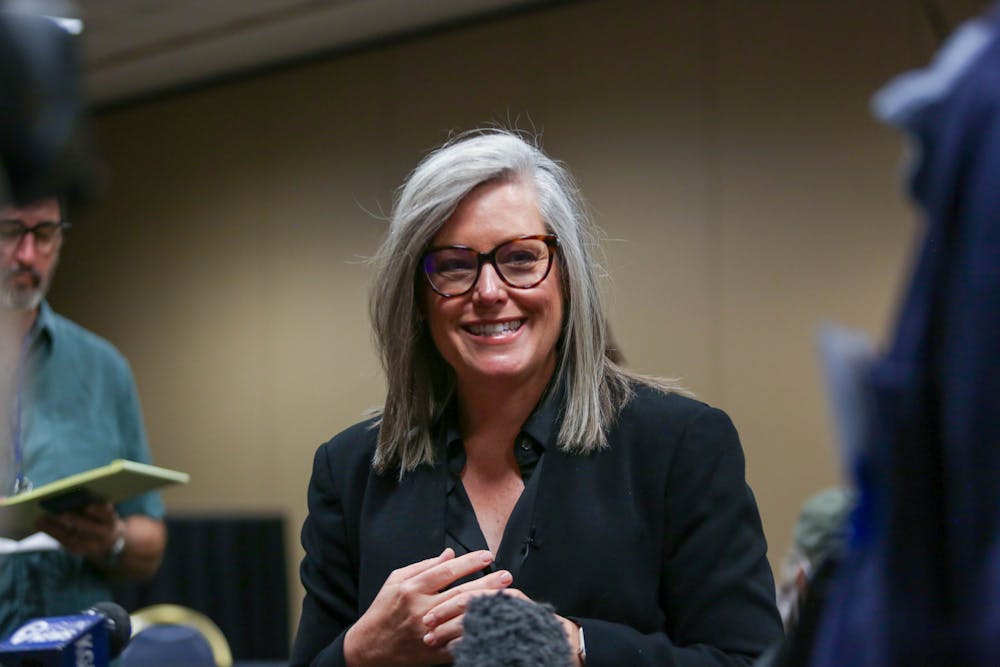On Mar. 13, Gov. Katie Hobbs gave a keynote speech on day two of the Water Resources Research 2024 Annual Conference at the University of Arizona, speaking optimistically about making partnerships for the future of Arizona water.
Hobbs spoke about the recently finalized lower basin state proposal for post-2026 Colorado River management. This plan was a collaborative effort between Arizona, California, and Nevada to balance water conservation responsibilities between all three states proposed to the Bureau of Reclamation.
The theme for the conference was “Implementing Water Solutions Through Partnerships”, with many of the presenters discussing collaborations to research and protect water resources.
READ MORE: Students, faculty and officials voice concerns on University of Arizona's financial problems
“We have been able to put our differences aside and through the power of collaboration, we have a deal that protects Arizona from draconian cuts and ensures no Arizonan will be forced to cut their water use,” Hobbs said.
Within the same week, an upper basin proposal coming out of Colorado, New Mexico, Wyoming and Utah was finalized, with a different approach for determining water usage and cuts.
“We have a long path ahead of us and we still need to see commitments from the upper basin to equitably share in the responsibility of protecting the Colorado River,” said Hobbs. “But we have made tremendous progress and I am confident that through collaboration and perseverance, we can find solutions.”
Looking within Arizona, Hobbs discussed groundwater legislation, criticizing SB1221. This bill would change the regulations for groundwater pumps to create specialized local regulations through a petition. This would be a change from the use of active management areas that currently regulate groundwater usage in at-risk areas.
“The legislature has moved forward with the Senate Bill 1221, making a mistake,” said Hobbs. “While proponents claim it would give rural communities a voice, it will silence them instead. It creates a convoluted process that would make it nearly impossible for our communities to manage their groundwater.”
Hobbs said she would veto SB1221 if it remained the same.
“There is still a path forward for compromise, but should Senate Bill 1221 remain unchanged, it will not receive my signature,” said Hobbs.
Some of the water professionals who spoke at the conference were from ASU, taking vastly different approaches to understanding and mitigating environmental concerns.
Amy Flores is a program manager within the College of Global Futures. Her project, Storm Smart Schools, is a collaboration with the Watershed Management Group. They work to bring rainwater collection, community training and native plants to four schools, with plans to expand in the next four years.
"There's tangible final products and there are intangibles. Intangibles being the relationships and how folks connect with water, how folks see what water they use ... And the tangible would be the actual rain garden itself," Flores said.
Somnath Mondal, a postdoctoral scholar at the School of Sustainable Engineering and the Built Environment, gave a presentation on advanced hydroclimatic monitoring. He implemented advanced modeling techniques to understand the true impact of Arizona’s drought.
"When our national agencies make our disaster database they have not included the hot drought of 2023. So I feel like it was our job to put this hot drought (because) it was very severe over the state of Arizona, New Mexico and the country of Mexico," Mondal said in a presentation.
The Arizona Water Innovation Initiative was a co-sponsor for the event. They also work collaboratively through partnerships in Arizona to generate water solutions. The WRRC conference gave an interdisciplinary, multifaceted look at water security in the state, and the keynote speech from Gov. Hobbs set the tone of optimism, with more work left to be done.
“I can say with certainty that we are moving the ball forward on securing our state’s water future,” said Hobbs. “What makes me the most hopeful is that there is such a fantastic group of water professionals here today who are taking these issues on and serving as leaders in Arizona’s water community.”
Edited by Shane Brennan and Angelina Steel.
Reach the reporter at syramir2@asu.edu and follow @nerdyoso on X.
Like The State Press on Facebook and follow @statepress on X.
Sophia is a senior studying biological sciences. This is her fifth semester with The State Press. She has also worked as a science and technology reporter.




